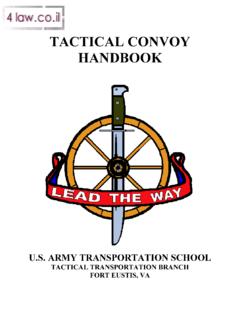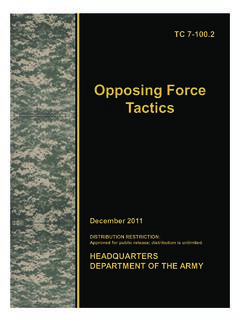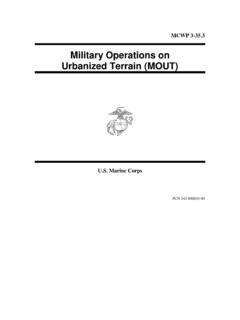Transcription of TACTICAL CONVOY HANDBOOK - JumpJet .info
1 TACTICAL CONVOY HANDBOOK ARMY TRANSPORTATION SCHOOL TACTICAL TRANSPORTATION BRANCH FORT EUSTIS, VA 1 TABLE OF CONTENTS CHAPTER 1 - DOCTRINAL 3 EXTRACT FROM FM 55-15, TRANSPORTATION REFERENCE DATA .. 3 APPENDIX B ROAD MOVEMENT ORDER 3 EXTRACT FROM FM 55-30, ARMY MOTOR TRANSPORT OPERATIONS .. 5 OPERATIONAL 5 CONVOY DEFENSE 9 VEHICLE 16 SAMPLE CONVOY 23 EXTRACT FROM FM 100-23, PEACE 24 RULES OF ENGAGEMENT, JTF FOR SOMOLIA GROUND 24 EXTRACT FROM FM 101-5-1, OPERATIONAL TERMS AND 25 MAP GRAPHICS .. 25 CHAPTER 2 - CONVOY SPECIFIC TE& 27 TASK: DEFEND MARCH ELEMENTS (63-2-1006).. 27 TASK: CONDUCT TACTICAL ROAD MARCH (63-2-1003).. 31 TASK: CONDUCT KFOR 34 CHAPTER 3 - FSB CONVOY 39 GENERAL TACTICAL CONVOY 39 CONVOY COMMANDER'S 48 CONVOY BRIEFING 49 CONVOY REHEARSALS 50 ROUTE RECONNAISSANCE 50 CHAPTER 4 CONVOY TACTICS, TECHNIQUES & PROCEDURES (TTPs).
2 51 TACTICAL CONVOY 51 CONVOY RISK MANAGEMENT 58 CONVOY PCI 62 BATTLE DRILLS .. 63 CONVOY RAT 71 METHODS AND TECHNIQUES FOR CONVOY PROCEDURES IN PEACE 74 CONVOY DEFENSE AT THE NATIONAL TRAINING 80 TACTICAL CONVOY LESSONS 84 CHAPTER 5 GUNTRUCKS .. 88 EXTRACT FROM FM 55-30, ANNEX 88 GUNTRUCKS OF AMBUSH ALLEY .. 89 VIETNAM CONVOY 94 CHAPTER 6 QUICK 96 PLATOON LEVEL OPORD 96 9 LINE MEDEVAC WEAPONS DATA ..101 UXO REPORT ..102 MINE CALL FOR FIRE ..103 NBC 1 OBSERVER S INITIAL OR FOLLOW-UP 2 PREFACE The purpose of this HANDBOOK is to provide the TACTICAL CONVOY commander with a handy reference for doctrine, tactics, techniques and procedures on CONVOY operations. This HANDBOOK contains extracts from doctrine as well as various CONVOY products.
3 This HANDBOOK is intended to be used as a field guide for TACTICAL CONVOY operations. The primary audience for this HANDBOOK is the commissioned and non-commissioned officers charged with leading TACTICAL convoys. However, the information contained herein can be used to plan and conduct convoys anywhere and under any conditions. Local reproduction is authorized and encouraged. The proponent for this HANDBOOK is the TACTICAL Transportation Branch of the United States Army Transportation School at Fort Eustis, Virginia. Point of contact for this HANDBOOK is: CPT Dean J. Dominique TACTICAL Transportation Instructor Army Transportation School Fort Eustis, VA 23604 DSN: 927-6420 Commercial : (757) 878-6420 E-mail : or 3 CHAPTER 1 - DOCTRINAL EXTRACTS The following chapter contains extracts from CONVOY related field manuals.
4 EXTRACT FROM FM 55-15, TRANSPORTATION REFERENCE DATA APPENDIX B ROAD MOVEMENT ORDER FORMAT (Classificat ion) Copy of copies Issuing headquarters Place of issue (may be in code) Date-time group of signature Message reference number ROAD MOVEMENT ORDER NO. (OR: ANNEX (ROAD MOVEMENT) to OPERATION ORDER NO) References: Maps, tables, and other relevant documents. Time zone used throughout the order: Task organization: 1. SITUATION a. Enemy Forces. b. Friendly Forces. c. Attachments and Detachments. 2. MISSION 3. EXECUTION a. Commander s Intent. b. Concept of Movement. c. Tasks of Subordinate Unit. d. Detailed Timings. e. Coordinating Instructions. (1) Order of march. (2) Routes. (3) Density. (4) Speed. (5) Method of movement. (6) Defense for move.
5 (7) Start, release, or other critical points. (8) CONVOY control. (9) Harbor areas. 1 (10) Halts. 4(11) Lighting. (12) Air support. f. Other (as necessary). 4. SERVICE SUPPORT a. Traffic Control. b. Recovery. c. Medical. d. Petroleum, Oil, and Lubricants. e. Water. 5. COMMAND AND SIGNAL a. Commanders. b. Communications. c. Position of Key Vehicles. Acknowledgment instructions. Last name of commander Rank Authentication: Appendixes: Distribution: NOTES 1. A harbor area is a space set aside for normal halts, traffic control, and emergency congestion relief. Harbor areas are used To hold vehicles at both ends of a crossing or defile. To make changes in density, especially at first or last light. To contain spillovers in serious delays (likely to be caused by enemy air attack or its results).
6 To allow columns to rest and carry out maintenance and decontamination. To allow elements to change position in column if there is a change in priorities. 1. Only the minimum number of headings should be used. Include any information common to two or more movement numbers under the general data paragraphs. 2. Since the table may be issued to personnel concerned with traffic control, security must be remembered. It may not be desirable to include dates or locations. 3. If the table is issued by itself, not as an annex to a more detailed order, the table must be signed or authenticated in the normal way. 4. Critical point is defined as a selected point along a route used for reference in giving instructions. Critical points include start points, release points, and other points along a route where interference with movement may occur or where timing is critical.
7 5. The movement number identifies a column or element of column during the whole of the movement. 5 EXTRACT FROM FM 55-30, ARMY MOTOR TRANSPORT OPERATIONS OPERATIONAL ENVIRONMENT 3-2. OPERATIONS SECURITY. There are four steps in the OPSEC planning sequence: Determine enemy capabilities for obtaining information about motor transport operations. Determine what information obtained by the enemy can compromise the operation. Determine which actions taken by motor transport units before an operation, if known and analyzed by the enemy, would give the enemy the information he needs. Determine what protective measures are necessary and where they must be implemented to maximize operations security. Operations security measures include: Counter surveillance.
8 Signal security. Physical security. Information security. a. Counter surveillance. Counter surveillance includes all active or passive measures taken to prevent threat forces from seeing your area, equipment, movements, and so forth. Counter surveillance techniques include-- Camouflaging and toning down trucks, including the headlights and windshields, when they are not moving. Moving at night or during periods of reduced visibility using blackout lights. Using terrain as concealment. Maintaining noise, litter, and light discipline. b. Signal Security. Signal security is the use of communications and electronics security techniques to prevent the disclosure of operational information. It includes the use of communications codes, secure voice equipment, and proper positioning of antennas.
9 Techniques for motor transport units include-- Keeping radio transmissions short. Maintaining signal silence whenever possible. Using wire communications when possible. Using low power in radios. c. Physical Security. Physical security is the use of security forces, barriers, dispersal, concealment, and camouflage to deny enemy access to facilities, areas, equipment, materiel, and personnel. Physical security protects operational information or activities. Some practical techniques include-- Employing security elements to the front and rear and, when required, to the flanks of convoys. Using listening and observation posts when in garrison and operations areas. Identifying avenues of approach and covering them with fields of fire.
10 6 Employing obstacles that impede the enemy. Using challenge and passwords. Using early warning devices. d. Information Security. Information security is the control of written, verbal, and graphic information to prevent the disclosure of operational information. To ensure information security- Never post information out in the open, such as on a vehicle windshield. Do not allow local civilians without clearances into work and assembly areas. Handle all classified and sensitive documents properly. 5-5. UNIT SOP. A complete SOP facilitates planning. At company level, SOPs should conform with those prepared by the next higher headquarters. At a minimum, the SOP should cover the following subjects: Duties of the CONVOY commander and other CONVOY control personnel.







